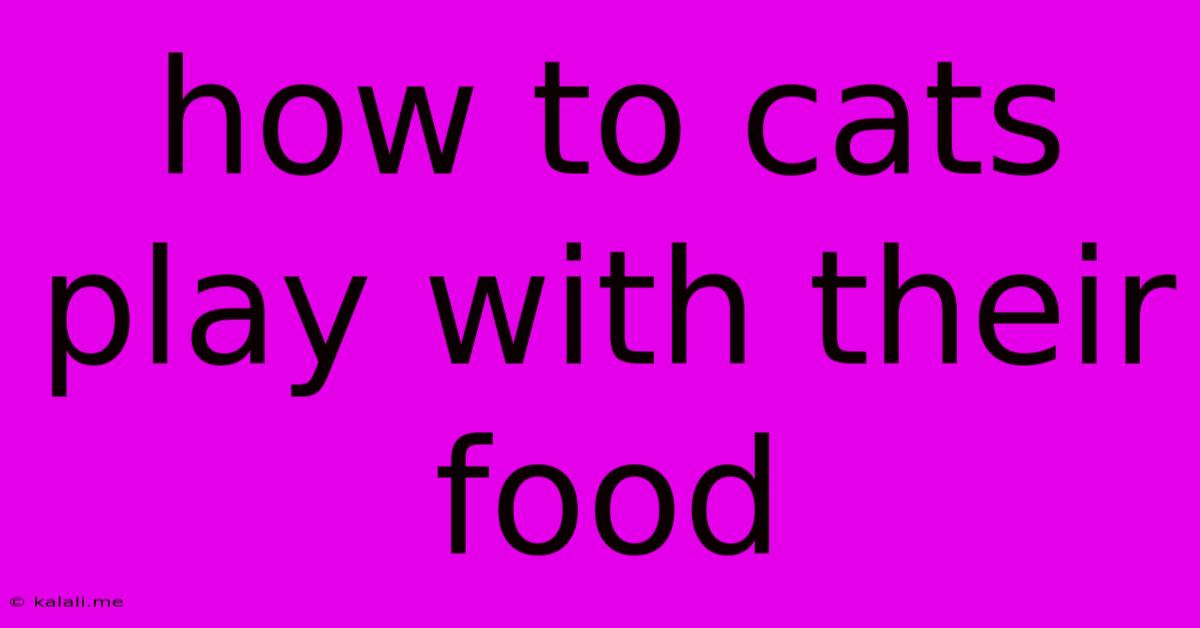How To Cats Play With Their Food
Kalali
Jun 04, 2025 · 3 min read

Table of Contents
Decoding the Feline Feast: How Cats Play with Their Food
Cats are enigmatic creatures, and their playful interactions with food can be particularly puzzling to their human companions. Why the elaborate batting, the meticulous nudging, and the seemingly endless chase? Understanding your cat's food-related games offers valuable insights into their natural instincts and can help you better meet their physical and mental needs. This article explores the various ways cats play with their food and the reasons behind this quirky behavior.
Why Do Cats Play with Their Food?
The answer is multifaceted and rooted in their evolutionary history as hunters. Several key factors contribute to this playful behavior:
1. Instinctive Hunting Behavior:
- Mimicking the Hunt: The playful batting and chasing of food mimics the process of stalking, pouncing, and capturing prey. Even domesticated cats retain these deeply ingrained instincts. The movement of the food, especially if it's kibble that rolls or bounces, triggers their predatory drive.
- Stimulating Prey Drive: This playful interaction provides mental stimulation, preventing boredom and keeping their minds sharp. A lack of mental enrichment can lead to behavioral problems, so this playful hunting behavior is actually beneficial.
- Testing for Safety: Before consuming their meal, a cat may gently nudge or bat at the food to assess its potential danger. This is a cautious approach rooted in survival instincts, ensuring the food is safe to eat.
2. Environmental Enrichment:
- Lack of Stimulation: A monotonous environment can lead cats to seek out entertainment in unusual ways, including playing with their food. Providing puzzle feeders, interactive toys, and climbing structures can significantly reduce this behavior.
- Food Boredom: Just like humans, cats can get bored with the same old food routine. Introducing new textures, flavors, and feeding methods can make mealtimes more engaging and less prone to playful manipulation.
3. Specific Food Characteristics:
- Texture and Movement: Dry kibble, with its tendency to roll and scatter, is more likely to elicit playful behavior than wet food. The unpredictable movement stimulates the hunting instinct.
- Smell and Taste: A strong aroma or particularly appealing taste can also heighten a cat's interest, leading to more playful interaction before consumption.
Recognizing Playful vs. Problem Behavior:
While playful food manipulation is often harmless, it's important to differentiate it from other potential issues:
- Medical Conditions: Changes in appetite, eating habits, and food interactions could indicate underlying medical problems. Consult your veterinarian if you notice significant changes.
- Stress or Anxiety: Excessive or obsessive food playing might indicate stress or anxiety. Identifying and addressing the underlying cause is crucial.
Encouraging Healthy Eating Habits:
Here are some tips to minimize excessive food play and promote healthy eating habits:
- Provide Environmental Enrichment: Offer a variety of toys, scratching posts, and climbing structures to keep your cat mentally and physically stimulated.
- Puzzle Feeders: These interactive feeders challenge your cat, mimicking the hunt and slowing down their eating.
- Vary Mealtimes and Food: Introduce new flavors, textures, and feeding methods to prevent boredom.
- Supervise Mealtimes: Monitor your cat during mealtimes to ensure they're eating appropriately and not engaging in excessive play.
- Consult a Veterinarian: If you're concerned about your cat's behavior, seek professional veterinary advice.
Understanding your cat's playful interactions with their food provides valuable insight into their natural instincts and helps you create a more enriched and stimulating environment. By providing adequate enrichment and addressing any underlying medical or behavioral issues, you can help your feline friend enjoy their meals without turning them into a game.
Latest Posts
Latest Posts
-
Death Is Swallowed Up In Victory
Jun 06, 2025
-
Can You Use Two Space Heaters At Once
Jun 06, 2025
-
How To Send Ctrl Alt Del To Remote Desktop
Jun 06, 2025
-
480 Volt Three Phase Line To Line
Jun 06, 2025
-
Do Eyes Change Color With Mood
Jun 06, 2025
Related Post
Thank you for visiting our website which covers about How To Cats Play With Their Food . We hope the information provided has been useful to you. Feel free to contact us if you have any questions or need further assistance. See you next time and don't miss to bookmark.